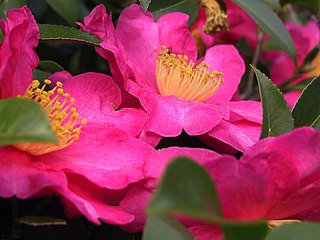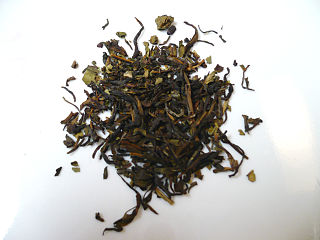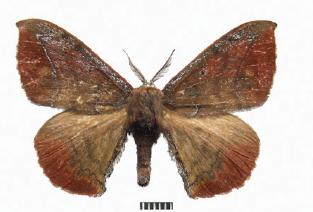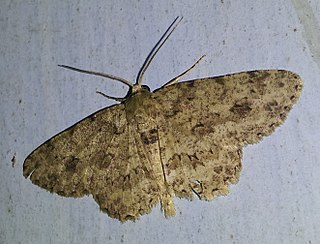
Camellia is a genus of flowering plants in the family Theaceae. They are found in eastern and southern Asia, from the Himalayas east to Japan and Indonesia. There are 100–300 described species, with some controversy over the exact number. There are also around 3,000 hybrids. The genus was named by Linnaeus after the Jesuit botanist Georg Joseph Kamel, who worked in the Philippines and described a species of camellia.

White tea may refer to one of several styles of tea which generally feature young or minimally processed leaves of the Camellia sinensis plant.

Theaceae, the tea family, is a family of flowering plants comprising shrubs and trees, including the economically important tea plant, and the ornamental camellias. It can be described as having from seven to 40 genera, depending on the source and the method of circumscription used. The family Ternstroemiaceae has been included within Theaceae; however, the APG III system of 2009 places it instead in Pentaphylacaceae. Most but not all species are native to China and East Asia.

Camellia sinensis is a species of evergreen shrubs or small trees in the flowering plant family Theaceae. Its leaves and leaf buds are used to produce tea. Common names include "tea plant", "tea shrub", and "tea tree".

Assam tea is a black tea named after the region of its production, Assam, India. It is manufactured specifically from the plant Camellia sinensis var. assamica (Masters). The Assam tea plant is indigenous to Assam—initial efforts to plant the Chinese varieties in Assam soil did not succeed. Assam tea is now mostly grown at or near sea level and is known for its body, briskness, malty flavour, and strong, bright colour. Assam teas, or blends containing Assam, are often sold as "breakfast" teas. For instance, Irish breakfast tea, a maltier and stronger breakfast tea, consists of small-sized Assam tea leaves.

Nilgiri tea is a drink made by infusing leaves of Camellia sinensis that is grown and processed in the Nilgiris district in Tamil Nadu, India. The leaves are processed as black tea, though some estates have expanded their product offerings to include leaves suitable for making green, white and oolong teas. It is generally described as being a brisk, fragrant and full-bodied tea. The region produces both rolled and crush, tear, curl tea and it is predominately used for blending. Nilgiri tea is also used for making iced tea and instant tea.

Darjeeling tea is a tea made from Camellia sinensis var. sinensis that is grown and processed in the Darjeeling or Kalimpong Districts in West Bengal, India. Since 2004, the term Darjeeling tea has been a registered geographical indication referring to products produced on certain estates within Darjeeling and Kalimpong. The tea leaves are processed as black tea, though some estates have expanded their product offerings to include leaves suitable for making green, white and oolong teas.

Endoclita is a genus of moths of the family Hepialidae. There are 60 described species found in eastern and southeast Asia and the Indian subcontinent.

Andraca bipunctata is a moth of the family Endromidae. It is found in China (Yunnan), India, Bhutan, northern Thailand, Myanmar and Nepal. The larvae are referred to as bunch caterpillars.

Adoxophyes fasciculana, the bell moth or orange tip moth, is a moth of the family Tortricidae. It was described by Francis Walker in 1866 from the Moluccas. It is also known from South Asia, Vietnam, Australia and the Pacific Islands. It is a polyphagous pest on several commercially important crops.

Camellia taliensis is a species of evergreen shrub or small tree whose leaves and leaf buds are used to produce tea.

Dysphania palmyra, the long blue tiger moth or blue day moth, is a moth of the family Geometridae. The species was first described by Caspar Stoll in 1790. It is found in India and Sri Lanka.

Ectropis bhurmitra, the tea twig caterpillar, is a moth of the family Geometridae. The species was first described by Francis Walker in 1860. A widespread Asian species, it is found around Indo-Australian tropics from India, Sri Lanka and Hong Kong, Taiwan, Thailand, New Guinea to Australian Queensland and the Solomon Islands.
Loxofidonia cingala is a moth of the family Geometridae first described by Frederic Moore in 1887. It is found in Sri Lanka.

Cheromettia apicata is a moth of the family Limacodidae first described by Frederic Moore in 1879. It is found in Oriental tropics such as Sri Lanka and India.
This page is based on this
Wikipedia article Text is available under the
CC BY-SA 4.0 license; additional terms may apply.
Images, videos and audio are available under their respective licenses.












